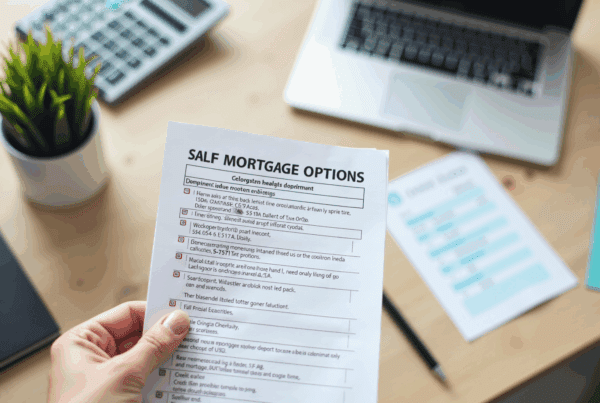Overview
This article serves as a caring and comprehensive step-by-step guide to mastering the mortgage process for a $400,000 house. We understand how daunting this journey can feel, and we’re here to support you every step of the way. It covers essential topics such as:
- Mortgage types
- Calculating monthly payments
- Navigating the application process
We know how important it is to grasp the fundamentals of mortgages. By comparing options among lenders and preparing the necessary documentation, you can ensure a smooth and informed home-buying experience. This guide ultimately aims to empower potential homeowners, helping them make sound financial decisions with confidence.
Introduction
Navigating the world of mortgages can feel overwhelming, especially when you’re considering a significant investment like a $400,000 home. We understand how daunting it is to face various mortgage types, fluctuating interest rates, and complex terms. Many potential homeowners find themselves unsure of which path to take and how to make the best choice for their unique financial situation.
This guide is here to support you every step of the way. We aim to demystify the mortgage process by offering clear steps and insights that empower you to make informed decisions. With so many options available, we want to help you feel confident in selecting the best mortgage that meets your needs.
So, how can you ensure you choose wisely? Let’s explore this journey together.
Understand Mortgage Basics for a $400,000 Home
Before embarking on your mortgage journey, we know how important it is to familiarize yourself with key terms and concepts that can make this process smoother:
-
Mortgage Types: It’s essential to understand the various mortgage options available, including fixed-rate, adjustable-rate, FHA, VA, and jumbo loans. Each type offers distinct features and benefits tailored to different financial situations. For example, fixed-interest loans provide stability through steady contributions, while variable-interest loans might present lower starting costs that can change over time.
-
Interest Charges: Understanding how interest charges affect your monthly payments and the total expense of your borrowing is crucial. As of August 2025, average interest percentages for fixed-rate mortgages hover around 6.72%. FHA and VA financing usually align closely with these figures, while jumbo mortgages might have somewhat elevated costs due to their greater sums. Even a small change in these rates can significantly impact your monthly budget, so it’s vital to stay informed.
-
Loan Terms: Mortgages come in various terms, such as 15, 20, or 30 years. Shorter durations typically lead to increased monthly costs but reduced interest paid throughout the loan’s lifespan. For instance, a mortgage on a 400k house with a 30-year fixed-rate at 6.72% could lead to monthly costs of around $2,580. In contrast, a 15-year term would raise those costs but lower total interest expenses, which is an important consideration.
-
Initial Deposits: Acquainting yourself with typical initial deposit requirements, usually ranging from 3% to 20% of the home’s purchase price, is also vital. A larger initial deposit can reduce your monthly expenses and eliminate private housing insurance (PMI), making homeownership more economical and accessible.
By understanding these fundamentals, you will be better prepared to make informed choices as you continue with your loan application. Remember, we’re here to support you every step of the way.

Calculate Your Monthly Payments and Affordability
Calculating your monthly mortgage on a 400k house can feel overwhelming, but we’re here to help you every step of the way. Follow these steps to gain clarity and confidence in your financial journey:
-
Determine Your Loan Amount: Start by subtracting your down payment from the home price. For instance, if you put down 20% ($80,000), your loan amount would be $320,000. This is the foundation of your mortgage.
-
Select Your Interest Level: It’s important to investigate current loan percentages. As of August 2025, the average rate for a 30-year fixed mortgage is around 7%. Keep in mind, this rate can vary based on factors like your location and credit score.
-
Choose Your Financing Period: Decide on a financing term, such as 30 years. This choice greatly impacts your monthly expenses and the total interest you’ll pay over time. Consider what works best for your financial situation.
-
Use a Mortgage Calculator: Enter your borrowing amount, interest percentage, and duration into a mortgage calculator. For example, with a mortgage on a 400k house at 7% for 30 years, your monthly payment would be approximately $2,128, excluding taxes and insurance. Remember, monthly contributions can vary based on different interest rates and financing terms, so it’s essential to explore various scenarios.
-
Assess Your Affordability: Reflect on your monthly income and other debts. A common guideline is that your loan cost should not exceed 28% of your gross monthly income. Striving for a Debt-to-Income Ratio (DTI) of 36% or less is also recommended. Many lenders require a maximum DTI of 43% for home loans, ensuring your existing debt remains manageable. For instance, if your monthly income is $7,500, aim for a housing payment of no more than $2,100.
-
Consider Additional Costs: Don’t forget to factor in potential expenses like property taxes, homeowners insurance, and private mortgage insurance (PMI). These can significantly influence your overall financing costs, so it’s wise to plan accordingly.
-
Explore Various Lenders: It’s beneficial to evaluate several lenders. A minor difference in terms could save you thousands over the life of the loan. Additionally, consider the option of an adjustable-rate loan (ARM), which may offer lower introductory rates. This could be a suitable choice if you plan to settle your loan quickly or refinance in a few years.
By following these steps, you can gain a clearer understanding of what you can afford and how much you need to allocate for your loan payments. Remember, we know how challenging this can be, and we’re here to support you on this journey.

Compare Mortgage Options and Lenders Effectively
To effectively compare mortgage options and lenders, follow these essential steps:
-
Research Different Loan Types: We know how challenging it can be to choose the right mortgage. Familiarize yourself with the advantages and disadvantages of various mortgage types, including the mortgage on a 400k house, such as fixed-rate and adjustable-rate mortgages (ARMs). Fixed-interest loans provide stability with steady payments, while ARMs may begin with lower costs but can vary over time, possibly resulting in increased payments later.
-
Gather Quotes from Multiple Lenders: Reach out to at least three lenders to obtain quotes. Providing the same financial information to each lender ensures accurate comparisons, allowing you to evaluate offers on a level playing field. Remember to evaluate prices, expenses, and conditions to find the best match for your needs. Consider collaborating with F5 Mortgage, recognized for its competitive pricing and personalized service, to expand your options.
-
Compare Interest Rates and APR: Examine both the interest rate and the annual percentage rate (APR). The APR includes not only the interest but also fees and other expenses related to the borrowing. A lower APR can lead to significant savings over the life of the mortgage on a 400k house, making it a crucial factor in your decision.
-
Evaluate Financing Terms: Consider the duration of the financing and any prepayment penalties. While shorter loan durations may lead to higher monthly costs, they generally accumulate less interest in total than a mortgage on a 400k house, which can be advantageous in the long term. Securing your loan rate with F5 Mortgage can offer stability in your monthly payments.
-
Check Lender Reviews and Reputation: Investigate lender reviews and customer satisfaction ratings. A lender with a strong reputation for service and reliability can enhance your loan experience and provide peace of mind.
-
Ask About Fees: Inquire about all potential fees, including closing costs and origination fees. These costs can differ greatly among lenders and significantly influence your overall loan expense.
By diligently comparing your options, including the competitive offerings from F5 Mortgage, you can select a mortgage on a 400k house that aligns with your financial goals and ensures a smoother home-buying experience.

Navigate the Mortgage Application Process
Navigating the mortgage application process for a mortgage on a 400k house can feel overwhelming, but with the right steps, you can approach it with confidence. Here’s how to make the journey smoother:
-
Gather Required Documentation: Start by preparing the necessary documents, including:
- Proof of income (W-2s, pay stubs, tax returns)
- Bank statements
- Employment verification
- Identification (driver’s license, Social Security number)
-
Get Pre-Approved: Before you begin house hunting, it’s essential to seek pre-approval from F5 Mortgage. You can apply online, by phone, or through chat, allowing you to tailor financing that aligns with your goals. This step involves submitting your financial information for review, helping you understand how much you can borrow. Remember, pre-approval not only clarifies your budget but also enhances your competitiveness in the market; sellers often prefer offers from pre-approved buyers. In fact, industry insights suggest that pre-approved buyers seeking a mortgage on a 400k house may experience faster closing times since much of the paperwork is already completed.
-
Complete the Application: When filling out the mortgage application form provided by F5 Mortgage, be thorough and accurate. This attention to detail helps avoid delays and ensures a smoother process.
-
Undergo the Underwriting Process: After submitting your application, the lender will review your financial information and assess your creditworthiness. This process may take several days to weeks, depending on the lender’s workload and your financial situation. We know how challenging this waiting period can be, and we’re here to support you every step of the way.
-
Once you’re approved, you’ll receive a financing estimate for a mortgage on a 400k house, outlining your terms, monthly payments, and closing expenses. Take the time to review this document carefully to ensure it aligns with your expectations and budget.
-
Schedule a Home Appraisal: The lender will require an appraisal to determine the home’s value. This step is crucial for completing your financing, as it guarantees that the property is valued at the amount you plan to borrow.
-
Close the Loan: After all conditions are met, you’ll schedule a closing date. During this time, you’ll sign the final paperwork and pay any closing costs. Once completed, you’ll receive the keys to your new home.
By following these steps, you can navigate the loan application process with confidence and ease. Remember, obtaining pre-approval from F5 Mortgage not only streamlines the process but also gives you a competitive edge in the housing market. An approval indicates that, based on your financial information, you’re a strong candidate for a mortgage, providing you with an estimate of your loan amount, interest rate, and potential monthly payment.

Conclusion
Understanding the intricacies of obtaining a mortgage on a $400,000 home is essential for prospective buyers. We know how challenging this can be, and this guide aims to illuminate the fundamental aspects of mortgages. From the different types available to the nuances of interest rates and loan terms, grasping these concepts can help you navigate the home-buying process with greater confidence and clarity.
Throughout the article, we shared key insights, including:
- How to calculate monthly payments
- Assess affordability
- Effectively compare various mortgage options and lenders
We also outlined steps for navigating the mortgage application process, emphasizing the importance of preparation and pre-approval. Each of these elements plays a critical role in ensuring a smooth journey toward homeownership.
Ultimately, mastering the mortgage process is not just about securing financing; it is about making informed decisions that align with your financial goals. By staying informed and utilizing available resources, such as mortgage calculators and lender comparisons, you can empower yourself to make the best choices for your unique situation. Embracing this knowledge will not only enhance your home-buying experience but also pave the way for a successful financial future.
Frequently Asked Questions
What are the different types of mortgages available?
The various mortgage options include fixed-rate, adjustable-rate, FHA, VA, and jumbo loans. Each type has distinct features and benefits suited to different financial situations.
How do interest charges affect my mortgage?
Interest charges impact your monthly payments and the total cost of borrowing. As of August 2025, average interest rates for fixed-rate mortgages are around 6.72%. Changes in these rates can significantly affect your budget.
What are the common loan terms for mortgages?
Mortgages typically come in terms of 15, 20, or 30 years. Shorter terms result in higher monthly payments but lower total interest paid over the loan’s lifespan.
What would be the monthly payment for a $400,000 home with a 30-year fixed-rate mortgage?
A 30-year fixed-rate mortgage at an interest rate of 6.72% could lead to monthly payments of approximately $2,580.
How does the loan term affect my monthly payments and interest expenses?
A shorter loan term generally results in higher monthly payments but reduces the total interest paid throughout the loan’s duration, making it an important consideration.
What are the typical initial deposit requirements for a mortgage?
Initial deposit requirements usually range from 3% to 20% of the home’s purchase price. A larger deposit can lower monthly expenses and eliminate private mortgage insurance (PMI).
Why is it important to understand mortgage basics before applying?
Familiarizing yourself with mortgage fundamentals helps you make informed choices during the loan application process and prepares you for the financial commitments involved.








